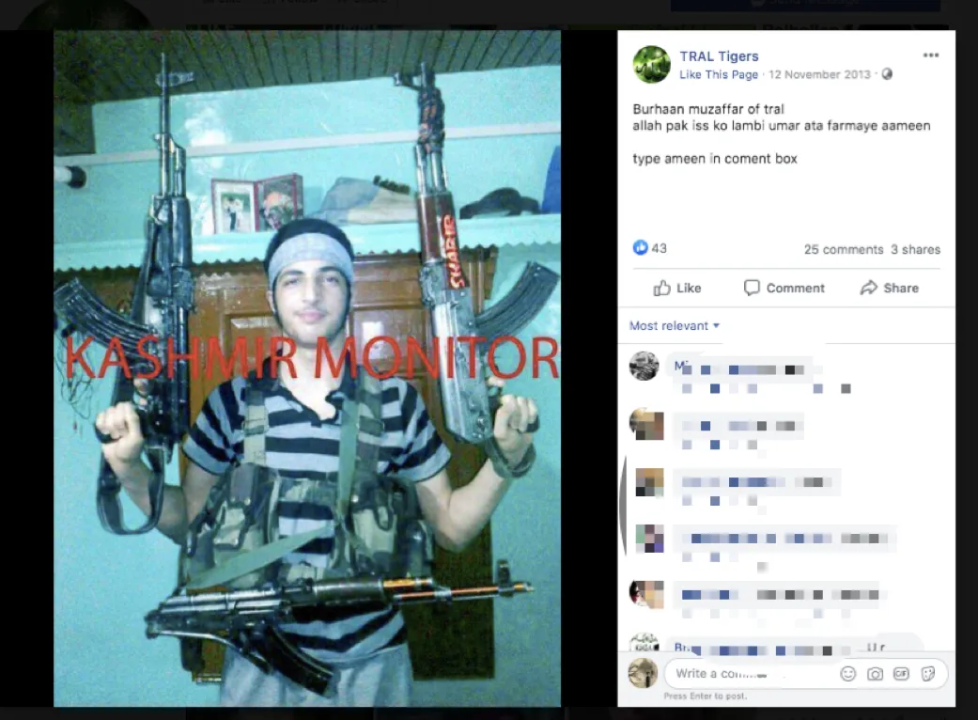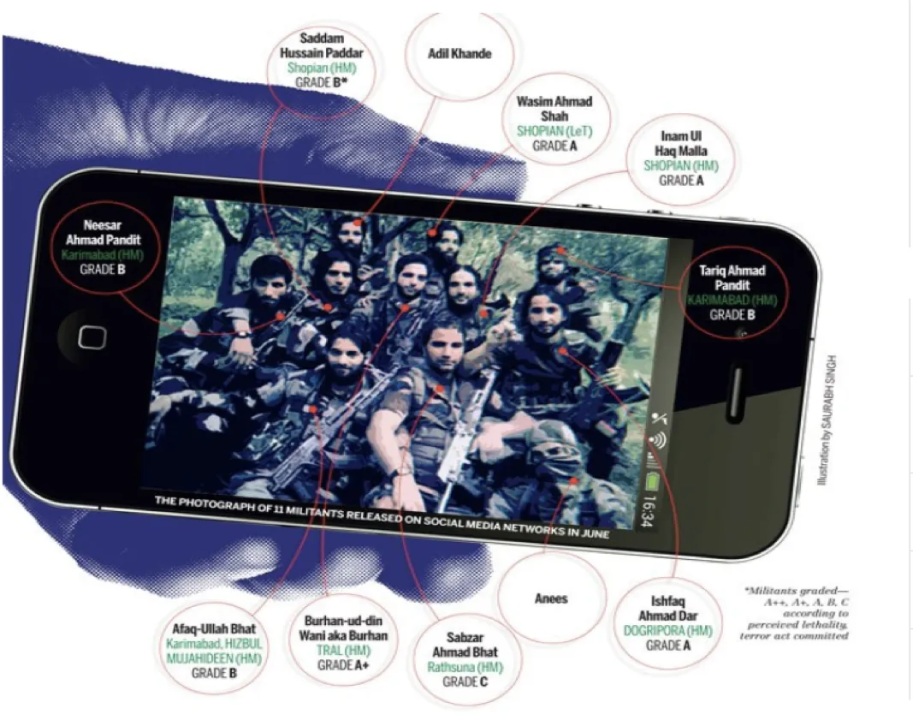Crowdsourcing Violence in Kashmir, Part 1
How Burhan Wani recruited disaffected Kashmiri youth to the insurgency via social media
Crowdsourcing Violence in Kashmir, Part 1

BANNER: (Source: @Dfrkaul/DFRLab via Stocksnap.io and Bannersnack)
This is the first article in a two-part series examining terror groups’ use of social media to attract popular support for the insurgency in Kashmir. Part 1 discusses the tactics and methods of pro-Pakistani militant Burhan Wani.
The Indian-administered state of Jammu and Kashmir lies at a geostrategic crossroads: it borders India to the south, Pakistan to the west, and China to the north and east. In recent history, India and Pakistan have engaged in three conventional conflicts over the state — in 1947, 1965, and 1999 — while a longstanding separatist insurgency has raged in the background.
On July 8, 2016, Indian security forces killed one of the key figures of that insurgency: Burhan Wani, the 22-year old leader of U.S.-designated terrorist organization Hizbul-Mujahidin (HM), a pro-Pakistani militant organization whose mission is to integrate Jammu and Kashmir fully with Pakistan. His death sparked a series of mass protests across the Kashmir Valley unprecedented in scale and intensity. The nearly four-month long protests led to 36 fatalities and 1,500 injuries, largely from heated clashes between separatist protestors and police. British media outlet BBC reported that most of the fatalities were young men aged between 16 and 26.
Wani’s enduring popularity lies in part in the efficiency with which he waged “social media jihad.” As one of the first terrorists in the region to gain fame via his use of social media, Wani provided future insurgents a model in how to leverage social media to attract popular support for insurgency. His fame amongst the wider population in the valley provided him a public platform from which he inspired the current generation of Kashmiri youth to take up arms. The Burhan Wani model of insurgency in turn encouraged a wave of digitally native homegrown militants to wage war for the hearts and minds of Kashmiris online.
A Prolific Social Media User

In the years leading up to his death, Wani was prolific on social media, uploading a number of photos and videos on popular platforms such as Facebook and WhatsApp that were then widely disseminated by his supporters.
Indian media outlet Firstpost reported that he was particularly active on Facebook, on which he ran several fan pages. In media content uploaded to the platform, he threatened attacks on Indian armed forces stationed in the state, as well as on Kashmiri police officers, who he termed “collaborators” of Indian forces.



Prior to the current phase of the insurgency, militants stayed anonymous for fear of being tracked by the Indian military. The identity of those conducting terror attacks would only be revealed by security services or by media outlets in the event of the terrorists’ death or capture. In direct contrast, Wani eschewed anonymity, instead choosing to show his face openly in social media posts.

Wani’s cohort consisted of some of the most wanted separatists who were affiliated with HM and other organizations advocating violence as a means of achieving their goals. One seemingly harmless photo (excepting the weapons), above, was prominently shared across social media and featured a group of militants that the Hindustan Times and other media outlets referred to as “Burhan’s boys.”

Along with the photo of “Burhan’s boys,” the videos Wani uploaded online characterized the life of an insurgent as both “glamorous” and “pious,” showing him and other heavily armed recruits joking and laughing with one another in Kashmir’s picturesque rural areas. By posting photographs and videos of militants in identifiable locations across the state, the terror group sought to attract disaffected Kashmiri youth to the militancy by downplaying its risks.
In other videos, Burhan attempted to link the insurgent movement with the broader religious identity of the state’s predominantly Muslim population by showing the insurgents praying and reciting Islamic religious verses together. According to Firstpost, a now-deleted video uploaded in August 2015 showed the 22-year old Wani urging the youth of Kashmir to “come and join us.”
The video itself showed the terrorist flanked by two armed associates with an assault rifle, pistol, and Quran visible in front of them. Another video released in June 2016 showed Wani threatening violence against the Kashmiri police force and Indian army, claiming that the terror group would “act against every man in uniform who stands for the Indian constitution.”
These posts made Burhan Wani a household name in the Kashmir Valley.
Terrorism in the Valley Post-Wani
Indian intelligence services claimed that more than 100 local youth joined the militancy in the period immediately following Burhan Wani’s death. While it is difficult to determine the precise number of local youth inspired by Wani to take up arms against the state, Indian officials have noted two emerging trends post-July 2016.
First is a spike in terror-related incidents. According to even conservative estimates based on data released in Indian Ministry of Home Affairs’s latest annual report, 2017 registered a 6.21 percent increase in the number of terrorist incidents and a 166.6 percent increase in civilian fatalities related to terrorist attacks and counterterrorism operations compared to the previous year.
While the official data released by the Indian government should be taken with a pinch of salt given the internationally disputed nature of the conflict, this trend is also reiterated by open-source data compiled by the South Asia Terrorism Portal, an Indian research organization not affiliated with the Indian government. According to its data, it lists 451 deaths and 586 terrorism-related incidents in 2018 alone, the highest number in the last decade.

Second is the rise of homegrown terrorism. Prior phases of violence in Kashmir had been driven by foreign fighters from Afghanistan, Pakistan, and other Muslim countries infiltrating the region through the line-of-control (LOC), a 740-km long de facto border that separates the Indian and Pakistani-controlled parts of the territory. In contrast, the most recent phase of violence has seen an increase in the number of homegrown radicalized youth carrying out attacks against Indian security forces stationed in the state.
According to data provided by sources within the army to Indian media outlet Economic Times, there has been a steady increase in homegrown fighters joining the insurgency since 2014. The data indicated that 53 locals joined terror groups in 2014. In 2015, there were 66 fresh recruits. 2016 led to a 55 percent increase in locals joining the insurgent movement, with 90 Kashmiris taking up arms within the space of a few weeks of Wani’s death. In 2017, this number increased to 126 and climbed to 191 in 2018.
This trend is also illustrated by the official data released by the Indian Ministry of Home Affairs — again, given the nature of the conflict, these numbers may not be entirely accurate, as the Indian government has incentive to inflate them in order to affect perceptions of the opposing side. According to the Indian government’s latest annual report, the same five-year period has seen an increase in the number of terrorists killed in armed clashes with security services, despite a steady decrease in the number of net infiltrations by foreign fighters between 2013 and 2017.


M.K Narayanan, India’s former national security advisor, also highlighted the increase in homegrown militants in an article for the Indian newspaper The Hindu. “[I]n marked contrast to earlier phases of trouble in Kashmir, the present movement is entirely home grown,” Narayanan wrote.
Burhan Wani’s rise and fall fundamentally altered the nature of the militant insurgency in the Kashmir Valley. Eager to replicate his successes, a new wave of terror groups have repurposed this model for their own operations. Part 2 of this series examines how current terror groups in the valley employ Wani’s tactics and methods to crowdsource violent protests and disrupt ongoing counterterrorism operations by Indian forces in the state.
Follow along for more in-depth analysis from our #DigitalSherlocks.

